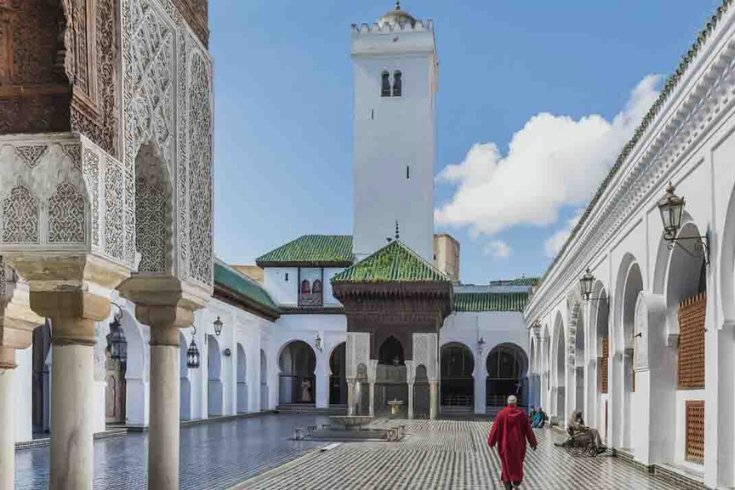In the heart of the ancient medina of Fez stands Al-Qarawiyyin Mosque, a witness to centuries of history, scholarship, and spirituality. It is not merely a mosque but also what is considered the oldest continuously operating university in the world. This comprehensive guide aims to explore Al-Qarawiyyin’s rich history, unique architecture, distinctive role as an educational institution, and its religious and cultural significance, while providing practical information for visitors about visitation rules and how to reach it in the center of the UNESCO World Heritage old city.
History of Al-Qarawiyyin Mosque: Centuries of Contribution and Expansion
The history of Al-Qarawiyyin Mosque dates back to the ninth century and has seen significant developments and expansions under the dynasties that ruled Morocco, making it one of the largest mosques in Africa and among the most important in the Islamic world.
Foundation of the Mosque: Fatima Al-Fihri in 859 CE
The story of Al-Qarawiyyin’s foundation goes back to a pious and knowledge-loving woman, Fatima Al-Fihri, who migrated with her family from Kairouan in Tunisia to Fez. After the death of her wealthy merchant father, Fatima decided to use her inheritance for a lasting charitable deed and established Al-Qarawiyyin Mosque in 859 CE. Historical accounts relate that she fasted throughout the entire construction period until the mosque was completed, which was initially modest compared to its current size.
Expansions under the Almoravids, Almohads, and Marinids (11th-15th centuries)
With the growth of Fez and its increasing population, the mosque underwent successive expansions under consecutive states:
- During the Almoravid era (11th-12th century), the mosque was expanded and the original minaret was added.
- Under Almohad rule, the mosque received additional renovations and improvements.
- However, the most notable expansions occurred during the Marinid period (13th-14th century), when the mosque reached approximately its current size, and many decorations and the distinctive minbar were added.
Architecture of Al-Qarawiyyin Mosque: Beauty and Authentic Islamic Art
The architecture of Al-Qarawiyyin stands as a living example of the evolution of Islamic architectural art in Morocco, with its spacious courtyards and intricate decorations that reflect the skill of Moroccan craftsmen throughout the ages.
General Layout and Size of the Mosque
Al-Qarawiyyin Mosque extends over an area of approximately 8,000 square meters and is characterized by its hypostyle hall design, with more than 270 columns supporting the arches and ceilings. The prayer halls can accommodate more than 20,000 worshippers, making it one of the largest mosques in the Islamic world, a result of successive expansions over the centuries.
Key Architectural Details: Courtyard, Minaret, and Mihrab
- The Courtyard (Sahn): The mosque features a large open inner courtyard, centered around an ablution fountain adorned with beautiful mosaic decorations.
- Al-Qarawiyyin Minaret: The mosque’s minaret is square in shape in the Moroccan-Andalusian style, and is one of the oldest and most distinctive minarets in Morocco.
- The Mihrab and Minbar: The mihrab is distinguished by its delicate stucco decorations, while the wooden minbar is considered a rare artistic masterpiece from the Marinid era.
Artistic Decorations: Zellige, Stucco, and Wood
Al-Qarawiyyin Mosque is rich with various Islamic decorative arts:
- Zellige (Mosaic): Walls, columns, and floors are adorned with colored tiles arranged in complex geometric designs.
- Stucco Carvings: Many walls and arches are covered with intricate stucco carvings featuring floral and geometric motifs and Quranic inscriptions.
- Woodwork: Evident in the doors and ceilings decorated with relief carvings, sometimes inlaid with ivory and mother-of-pearl.
Among the distinctive elements is also the historical water clock located outside the mosque, considered one of the oldest water clocks in the world, although it is rarely operational today.
Al-Qarawiyyin University: The Oldest Operating University in the World and a Beacon of Knowledge
Besides being a mosque for prayer, Al-Qarawiyyin gained its most prominent international fame as a historical educational center, recognized as the oldest continuously operating university in the world, predating European universities by many centuries.
Recognition as the Oldest University in the World
Al-Qarawiyyin has received recognition from UNESCO and the Guinness Book of World Records as the oldest continuously operating educational institution in the world, with studies beginning there since the ninth century. This predates the oldest European universities such as Bologna (1088) and Oxford (1096) by more than two centuries.
Curricula and Prominent Scholars and Graduates
Al-Qarawiyyin University became famous for teaching Islamic and scientific disciplines:
- Religious sciences: Quran, Hadith, Maliki jurisprudence, and exegesis.
- Arabic language and literature: grammar, morphology, and rhetoric.
- Rational sciences: logic, philosophy, mathematics, astronomy, and medicine.
Among the prominent scholars associated with Al-Qarawiyyin are Ibn Khaldun, the founder of sociology; the philosopher Averroes (Ibn Rushd); the thinker Maimonides; and many other scholars who enriched human civilization with their knowledge and works.
Al-Qarawiyyin Historical Library and Its Manuscripts
The Al-Qarawiyyin Library is considered one of the oldest libraries in the world and houses a valuable collection of rare manuscripts, some dating back to the ninth century. The manuscripts include ancient copies of the Quran and books on medicine, astronomy, mathematics, and philosophy. The library has undergone comprehensive restoration in recent years, and part of it has become available for visits under specific conditions.
Religious and Cultural Significance of Al-Qarawiyyin Mosque in Fez
Al-Qarawiyyin Mosque holds a prestigious position in the religious and cultural heart of Morocco:
- It is considered the most important mosque in Fez and one of the most important in Morocco.
- It represents a symbol of Fez’s status as the spiritual and academic capital of the Kingdom of Morocco.
- For centuries, it formed a center for the Maliki school of thought, the prevalent school in Morocco and North Africa.
- It represents the continuity of worship and education for more than 1,160 years without interruption.
Visiting Al-Qarawiyyin Mosque: Practical Guide and Access Rules
Al-Qarawiyyin Mosque is an important landmark for visitors to Fez, but it is essential to know its specific access rules to respect the sanctity of the place and understand how to make the most of visiting it.
Access to the Mosque for Non-Muslims
Please note that entry to the main building of Al-Qarawiyyin Mosque (prayer halls and inner courtyard) is restricted to Muslims only. However, non-Muslims can view parts of the mosque’s internal courtyard from some gates open to the street, such as the gate near Al-Attarine Madrasa. It is also possible to see the minaret and exterior walls from surrounding streets or from the terraces of nearby cafes and restaurants that offer views of the mosque.
Access for Muslim Worshippers
Muslims can enter the mosque for prayer during the five daily prayer times, especially Friday prayer which sees a large attendance. It is preferable to enter the mosque quietly and respectfully, following the usual etiquette of mosques.
Location of the Mosque and How to Reach It in Old Fez
Al-Qarawiyyin Mosque is located in the heart of the old city (Fes el-Bali), surrounded by traditional souks and narrow alleys. It is situated near other important landmarks such as Al-Attarine Madrasa and the Zawiya of Moulay Idriss II. To reach it, you can:
- Enter through Bab Boujloud (the Blue Gate) and walk through the souks for 15-20 minutes.
- Follow signs leading to “Al-Qarawiyyin Square” or “Al-Qarawiyyin Quarter.”
- Enlist the help of a local tour guide to avoid getting lost in the intricate alleys.
Best Time for Viewing from the Outside
It is best to visit the area surrounding Al-Qarawiyyin Mosque during daylight hours when visibility is good and the surrounding souks are active. It is advisable to avoid prayer times, especially Friday prayer, due to the heavy congestion around the mosque.
Respecting the Sanctity of the Place
When visiting the area around the mosque, please:
- Wear modest clothing that covers shoulders and knees.
- Maintain quiet and respect for worshippers.
- Ask permission before taking photographs, especially of people.
- Do not obstruct the movement of worshippers entering and exiting the mosque.
Landmarks Near Al-Qarawiyyin Mosque
Al-Attarine Madrasa
Located just steps away from one of the entrances to Al-Qarawiyyin Mosque, it is a Marinid architectural masterpiece that can be visited with a ticket. From here, parts of Al-Qarawiyyin’s courtyard can be seen.
Zawiya of Moulay Idriss II
The shrine of the founder of Fez is located a short distance from Al-Qarawiyyin Mosque and is considered one of the most sacred places in the city.
Fez Souks
The mosque is surrounded by specialized traditional markets, from the coppersmiths’ souk (Seffarine) to the spice dealers’ souk (Attarine), the wood souk, and many others.
Al-Qarawiyyin Library
It forms part of the Al-Qarawiyyin complex and has recently been restored, with a portion now open for visits with special permission.
Conclusion: Al-Qarawiyyin Mosque… Fez’s Eternal Spiritual and Academic Heritage
Al-Qarawiyyin Mosque remains one of the most important historical and spiritual monuments not only in Fez but in the entire Islamic world. It embodies the story of an exceptional achievement that began with the initiative of a pious Muslim woman and developed over the centuries to become a beacon of science, knowledge, and worship.
Although access to the mosque is limited for non-Muslims, discovering its story, admiring its architecture from the outside, and understanding its pivotal role in the history of Fez and Islamic civilization remains a rich and essential experience for any visitor to the old city.
We invite you to visit the Al-Qarawiyyin Mosque area and discover the splendor of this exceptional monument from the available viewing points, while respecting the sanctity of the place and the visitation rules. Don’t forget to share your experience and impressions of this historical edifice in the comments.






Leave a reply